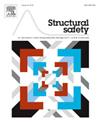Optimal redundancy allocation and quality control in structural systems
IF 6.3
1区 工程技术
Q1 ENGINEERING, CIVIL
引用次数: 0
Abstract
Reliability-Based and Risk-Based design optimization are popular research topics nowadays. Yet, not many studies have addressed the progressive collapse, the optimal robustness nor the optimal redundancy of structural systems. By way of fundamental examples, it is shown herein that redundancy is of little benefit, unless the structural system is exposed to external ‘shocks’. These ‘shocks’ are abnormal loading events; unanticipated failure modes; gross errors in design, construction or operation; operational abuse; and other factors that have historically contributed to observed structural collapses. Shocks may lead to structural damage or complete loss of structural members. The effect of such shocks on system reliability is generically represented by a member damage probability. This is a hazard-imposed damage probability, which is shown to be the key factor justifying the additional spending on structural redundancy. In structural reliability theory, it is understood that quality control should handle gross errors and their impacts; yet, it is shown herein that optimal redundancy is related to the frequency of inspections. The study reveals an intricate interaction between optimal redundancy and optimal quality control by way of inspections, challenging the separation between structural reliability theory and quality control in safety management.
结构系统的最优冗余分配与质量控制
基于可靠性和基于风险的设计优化是当今研究的热点。然而,针对结构体系的渐进崩溃、最优鲁棒性和最优冗余性的研究并不多见。通过基本的例子,本文表明,除非结构系统暴露于外部“冲击”,否则冗余几乎没有好处。这些“冲击”是异常加载事件;意外失效模式;设计、施工、操作出现重大失误的;操作滥用;历史上其他因素导致了观察到的结构崩塌。冲击可能导致结构损坏或结构构件完全丧失。这种冲击对系统可靠性的影响一般用构件损坏概率来表示。这是一个危险造成的损坏概率,这是证明在结构冗余上额外支出的关键因素。在结构可靠性理论中,质量控制应处理大误差及其影响;然而,本文表明,最优冗余与检查频率有关。研究揭示了最优冗余和最优质量控制之间复杂的相互作用,对安全管理中结构可靠性理论与质量控制的分离提出了挑战。
本文章由计算机程序翻译,如有差异,请以英文原文为准。
求助全文
约1分钟内获得全文
求助全文
来源期刊

Structural Safety
工程技术-工程:土木
CiteScore
11.30
自引率
8.60%
发文量
67
审稿时长
53 days
期刊介绍:
Structural Safety is an international journal devoted to integrated risk assessment for a wide range of constructed facilities such as buildings, bridges, earth structures, offshore facilities, dams, lifelines and nuclear structural systems. Its purpose is to foster communication about risk and reliability among technical disciplines involved in design and construction, and to enhance the use of risk management in the constructed environment
 求助内容:
求助内容: 应助结果提醒方式:
应助结果提醒方式:


